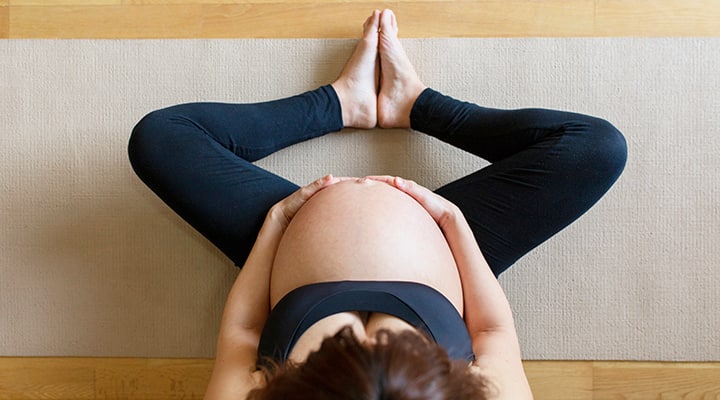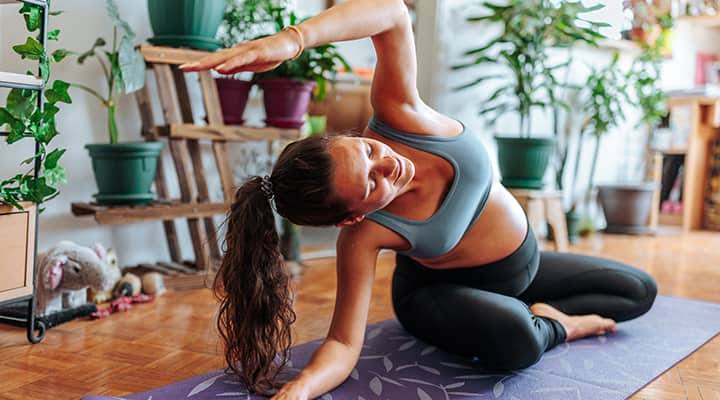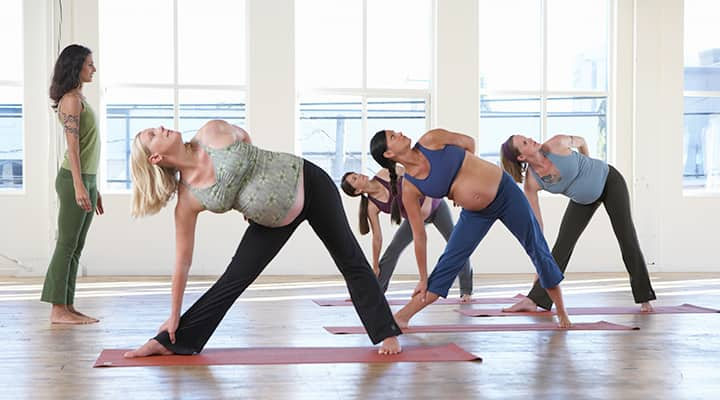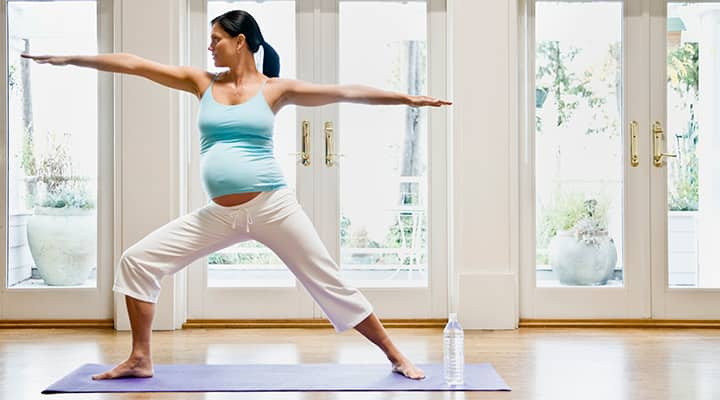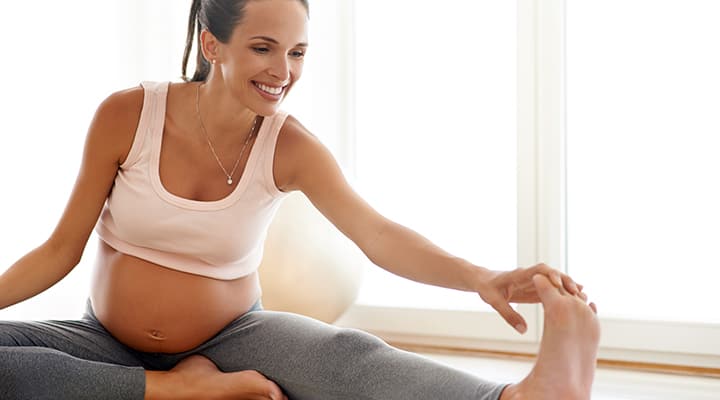
Prenatal Yoga: Benefits, Tips and Poses
Published: November 2024
Maintaining good health is important for expectant mothers; statistics show that the healthier the mom, the healthier the baby. Taking a prenatal vitamin is crucial, but so is keeping up your fitness level. You're not just eating for two, after all: you're moving and breathing for two.
Prenatal yoga is a great way to manage stress, strengthen your body, and prepare for your baby's delivery. We've got tips and poses to help you enjoy the benefits of prenatal yoga and make the most of this gentle movement during pregnancy and postpartum.
What is prenatal yoga?
Prenatal yoga is a practice designed especially for pregnant women. Like regular yoga, it involves breathing exercises and poses (also called asanas) that help calm and focus your mind while exercising and stretching your body.
Prenatal yoga practice helps support mental and physical health during pregnancy and prepare you for childbirth and postpartum. Additionally, this type of yoga takes into account the unique needs of your pregnant body, offering modifications in the poses or props. It is tailored to other safety concerns, as well, such as maintaining a comfortable temperature in the studio so expectant mothers do not get too hot, and avoiding poses that put pressure on the belly.
Prenatal yoga is a safe and enjoyable way to work out the body as well as the mind. So grab a smoothie, settle in, and let's learn about this yoga style.
What are the benefits of prenatal yoga?
When it comes to this practice, research shows moms-to-be can expect the following benefits from prenatal yoga:
- Boosts mood. Like other types of yoga, prenatal yoga has been studied for its mental health benefits and shown to promote mood health and healthy stress management.
- Encourages relaxation and quality sleep. Thanks to its gentle flow and mindfulness, yoga supports relaxation. In a study of third-trimester pregnant women, prenatal yoga also significantly encouraged sleep quality—and better sleep benefits the health of both mom and baby.
- Maintains fitness. Yoga in general has many physical benefits, including promoting lean muscle mass, flexibility and balance.
- Helps prepare you for labor. Besides strengthening and lengthening muscles, a meta-analysis of research shows prenatal yoga significantly supports comfort during labor and relief from labor pain.
When should you start prenatal yoga?
The timing of prenatal yoga depends on the individual and how their pregnancy is going. There is only one hard and fast rule for when to begin this practice: talk with your healthcare provider first. Most women with low-risk pregnancies will likely get the green light from their doctor to begin prenatal yoga at any point during their pregnancy.
If you haven't done yoga before, or if you have a higher-risk pregnancy, your doctor may advise you to wait until the second trimester when the pregnancy is better established. If you're an experienced yoga practitioner, it is most likely fine to continue practicing yoga throughout your pregnancy, but again, your exercise plan should be discussed with your doctor at every prenatal appointment, especially if these are new-to-you exercises.
Top 10 Prenatal Yoga Poses
Whether you are a seasoned yogi or new to the practice, it is recommended that you attend a prenatal yoga class to get information and feedback on how to practice poses that will best benefit you and your pregnancy. Most of these poses will feel especially good as your body opens up in the second trimester.
1. Goddess pose (utkata konasana)
There is no better name than this one to depict the amazing feat of bringing life into the world. The external rotation of the hips helps open the hips and pelvis, preparing your body for proper positioning for delivery.
- Walk the feet out wider than hip distance, toes pointing outward and heels toward the midline of the body.
- Bend the knees into a high squat and lower your hips.
- This is the beginning of a prenatal flow, so just warm up here and feel free to sway around a little.
2. Triangle pose (trikonasana)
This pose builds strength while energizing the entire body. It opens the hips, strengthens the core, provides a side bend and a twist, and opens the heart.
- Bring the feet together to a standing position. Step the right foot forward, toes facing forward with a micro bend in the right knee. The toes of the left foot will be facing to the left of the room, leg straight.
- Imagine that your hips are the cover of a book. Open the left hip toward the left, and the right hip toward the right. Extend the right arm toward the front of the room, and the left arm toward the back of the room.
- Reach away with the top of the head as you lean toward the right. If this is your first time practicing, allow the right hand to come to the right leg. Reach the left arm up toward the ceiling.
- Stay here for a few breath cycles, then come back to center and repeat on the other side.
3. Standing forward bend (uttanasana)
This is a calming pose that helps reduce stress. It strengthens the thighs and knees while elongating the hamstrings, hips, and back.
- Walk the feet out to just wider than hip distance apart, toes facing forward.
- Bend forward with straight back, leading with the chest. The knees can bend as much as you want or need.
- Allow the head and arms to hang heavy. The hands can go on the floor, or to opposite elbows, whatever feels good for you.
4. Low lunge (anjaneyasana)
This pose helps alleviate lower body soreness while opening up the hip flexors and psoas muscles while toning the pelvic floor. (Note: A strong pelvic floor may make childbirth easier.) It also strengthens the thigh muscles.
- Slowly make your way onto hands and knees. Bring your right foot forward, between the hands. Hands can be on blocks to allow more space for your baby bump.
- Shift the hips forward so you feel an opening in the front of the left hip, leaning toward the right to open the left side.
- Stay here for a few breath cycles before bringing the right foot back to meet the left.
- Repeat on the opposite side.
5. Cow (bitilasana)
Cow and cat poses work together. Both start in tabletop.
- Practice the stance you will take in a few years when your little one wants to use you for an imaginary horsey ride: you begin on hands and knees with your shoulders above the hands, and hips above the knees.
- For cow, inhale starting with expanding the belly first and bringing the breath into the chest. Look up and move the chin away from the chest for a gentle spinal extension.
6. Cat (marjaryasana)
- Exhale and press hands into the mat, arching the spine up and dropping the crown of the head toward the ground.
- This can be especially comforting for those experiencing back pain.
7. Head-to-knee forward bend (janu sirsasana)
The twist in this pose is very gentle. It is calming to the mind, and helps elongate the spine, shoulders, muscles in the pelvis, and hamstrings.
- From tabletop, slowly make your way to a seated pose. Raising the hips with a folded blanket or block will help this forward bend be more comfortable.
- Extend the right leg and bend the left knee so the foot rests on the inside of the right thigh.
- Lean forward over the right leg, leading with the chest.
- Allow the hands to rest on the leg or on the mat. Stay here for a few breath cycles and repeat on the left side.
8. Wide-angle seated forward bend (upavistha konasana)
This pose helps with flexibility in the back, hips, and both legs simultaneously.
- Unbend the right leg. Keep the legs separated to make space for the belly, but allow them to be spread out to your level of comfort.
- Extend the arms toward the ceiling, bending at the hips as you fold forward.
- Allow the hands to go to the floor. Stay here for a few breath cycles.
9. Bound angle pose (baddha konasana)
This pose helps calm the mind while opening the groin and outer thighs.
- To get into this pose from the last one, simply bend the knees and bring the feet together.
- Keep your mind on your breathing as you lengthen your spine.
- Your hands can rest on your legs or feet.
10. Final resting pose on the side (parsva savasana)
Yoga classes typically end with this pose, which encourages deep relaxation, calming the mind and body. Remember that you do not want to lie directly on your back. Laying on the left side helps maintain blood flow to the uterus.
- Get set up to have a cushion under your head and at the knees. You can also place a bolster under your torso so you are at an incline.
- Lay on the left side with left knee unbent. The right knee can be bent and resting on a cushion or block.
- Soften the body, surrendering to the quiet stillness of the mind.
Explore Our Best Active Lifestyle & Fitness Supplements
Prenatal yoga: Things you need to know
Just as there are foods and drinks you should avoid while you are pregnant, there are yoga poses to avoid when you are pregnant. These include anything too strenuous or any poses that put pressure on your belly. As your belly grows, you will need to modify many poses. Anything lying on your stomach or flat on your back will be uncomfortable and off-limits. Do not lay directly on your back after 20 weeks.
Consider going to a prenatal yoga class with an instructor who can help guide you safely through poses. Avoid pushing yourself past the point of being able to speak normally. Remember that during this time, a gentle workout will serve you best. That means:
- No deep twists
- No deep backbends
- No heated yoga
- No inversions (being upside down) unless those were part of your regular practice and you discussed them with your doctor and prenatal yoga teacher first. (Do not worry, you can resume these postpartum!)
It is important during prenatal yoga to know your limits. Stop if you feel uncomfortable. If you experience anything during your workout that doesn't feel like usual pregnancy symptoms, call your healthcare provider.
Can yoga affect implantation?
Generally, yoga is safe and does not have adverse effects on implantation. In fact, it may offer some benefits for couples looking to conceive. If you are undergoing IVF, please speak with a doctor before trying any exercise routine.
Can I do yoga in my first trimester?
Generally, yoga can be practiced safely during the first trimester, especially in a common pregnancy. Remember to check with your doctor first.
What is the difference between prenatal yoga and regular yoga?
The significant aims of yoga are to address strength, flexibility and balance. There isn't a massive difference, except prenatal yoga is tailored to pregnant women. So some more-intense yoga poses may be off the table (such as no deep twists or inversions), and the sessions may be more relaxing and less vigorous. Additionally, hot yoga is off-limits during pregnancy, so go to a room, studio, or gym that maintains a comfortable temperature.
What else can I do to support my health and my baby's health?
As the saying goes, babies eat what moms eat. Be sure you are getting the vitamins and minerals your healthcare practitioner recommends, usually through a high-quality prenatal vitamin that includes nutrients like choline, folic acid, and DHA to support your baby's brain and neural development.
About the Author: Sarah A. Walker, Ph.D., LMFT, is a licensed marriage and family therapist, an artist, a certified hypnotherapist, an EMDR therapist and a registered yoga teacher. As a lifelong learner and a creative, she brings these skill sets to her specialties and expertise. She integrates creative endeavors as part of the whole mind-body innovative approach to mental health and total well-being.
Website: www.secondfloorsanctuary.com
References
- Azward H, et al. "Prenatal yoga exercise improves sleep quality in the third trimester of pregnant women." Gac Sanit. 2021. https://pubmed.ncbi.nlm.nih.gov/34929826/
- Bolanthakodi C, et al. "Prenatal Yoga: Effects on Alleviation of Labor Pain and Birth Outcomes." J Altern Complement Med. December 2018. https://pubmed.ncbi.nlm.nih.gov/30160530/
- Darbandi S, et al. "Yoga Can Improve Assisted Reproduction Technology Outcomes in Couples With Infertility." Altern Ther Health Med. July 2018. https://pubmed.ncbi.nlm.nih.gov/29112941/
- Field T, et al. "Yoga and massage therapy reduce prenatal depression and prematurity." J Bodyw Mov Ther. April 2012. https://pubmed.ncbi.nlm.nih.gov/22464118/
- Lin IH, et al. "Efficacy of Prenatal Yoga in the Treatment of Depression and Anxiety during Pregnancy: A Systematic Review and Meta-Analysis." Int J Environ Res Public Health. April 2022. https://pubmed.ncbi.nlm.nih.gov/35564762/
- Villar-Alises O, et al. "Prenatal Yoga-Based Interventions May Improve Mental Health during Pregnancy: An Overview of Systematic Reviews with Meta-Analysis." Int J Environ Res Public Health. January 2023. https://pubmed.ncbi.nlm.nih.gov/36674309/
- Zhang L, Wang S. "The Efficacy of Prenatal Yoga on Labor Pain: A Systematic Review and Meta-analysis." Altern Ther Health Med. July 2023. https://pubmed.ncbi.nlm.nih.gov/37023315/
Always be in the know!
Access the latest deals, wellness news, expert health tips & more!


